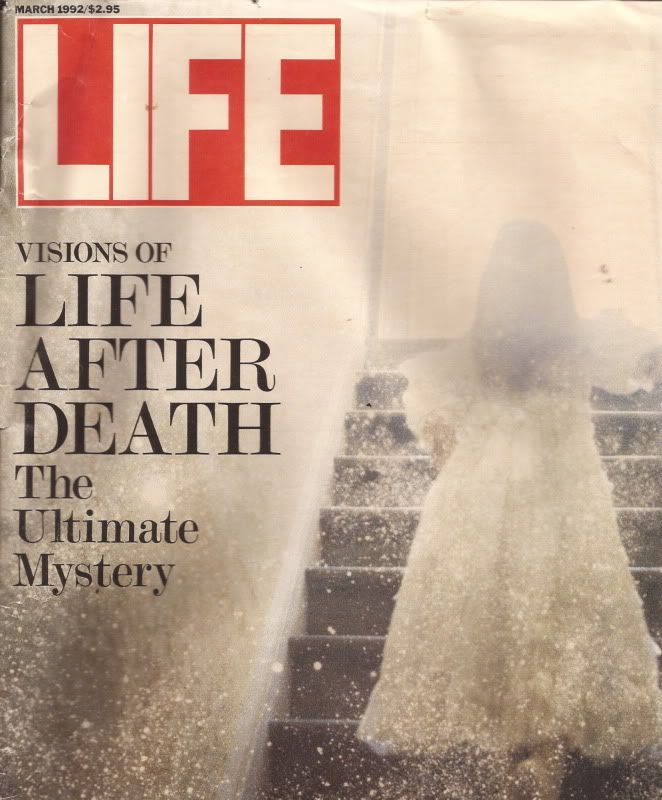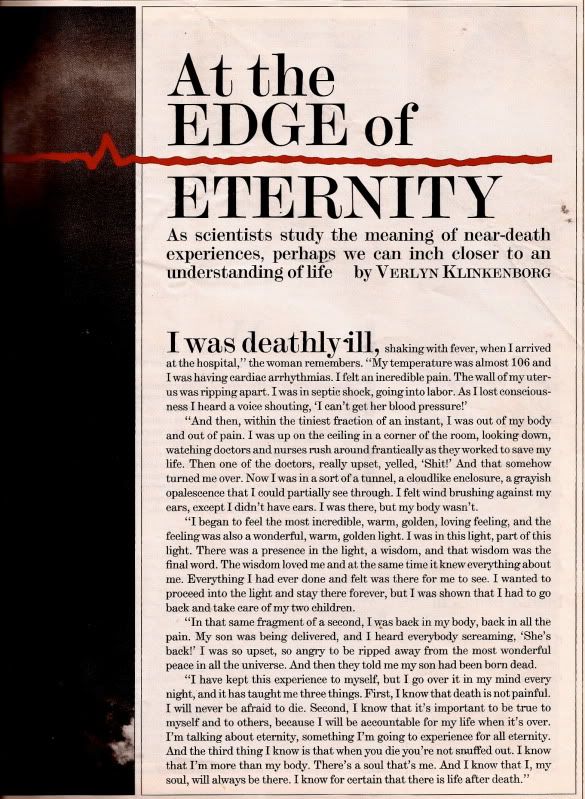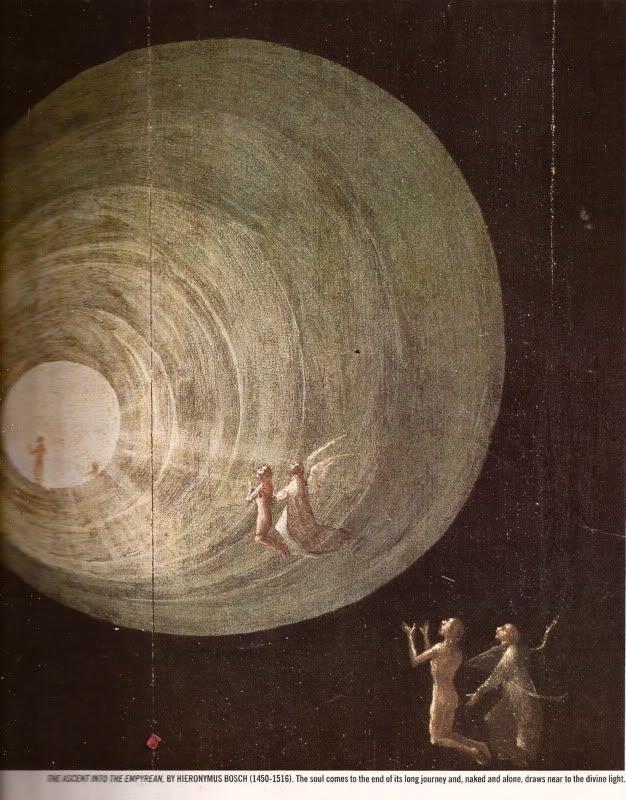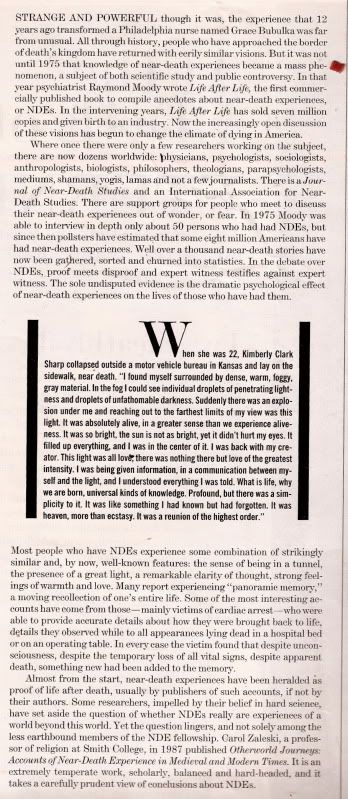

I was deathly ill, shaking with fever, when I arrived at the hospital, “the woman remembers. “My temperature was almost 106 and I was having cardiac arrhythmias. I felt an incredible pain. The wall of my uterus was ripping apart. I was in septic shock, going into labor. As I lost consciousness I heard a voice shouting, ’ I can’t get her blood pressure!’ ” And then, within the tiniest fraction of an instant, I was out of my body and out of pain. I was up on the ceiling in a corner of the room, looking down, watching doctors and nurses rush around frantically as they worked to save my life. Then one of the doctors, really upset, yelled, ‘Shit!’ And that somehow turned me over. Now I was in a sort of a tunnel, a cloudlike enclosure, a grayish opalescence that I could partially see through. I felt wind brushing against my ears, except I didn’t have ears. I was there, but my body wasn’t. “I began to feel the most incredible, warm, golden, loving feeling, and the feeling was also a wonderful, warm, golden light. I was in this light, part of this light. There was a presence in the light, a wisdom, and that wisdom was the final word. The wisdom loved me and at the same time it knew everything about me. Everything I had ever done and felt was there for me to see. I wanted to proceed into the light and stay there forever, but I was shown that I had to go back and take care of my two children. “In that same fragment of a second, I was back in my body, back in all the pain. My son was being delivered, and I heard everybody screaming, ‘She’s back!’ I was so upset, so angry to be ripped away from the most wonderful peace in all the universe. And then they told me my son had been born dead. “I have kept this experience to myself, but I go over it in my mind every night, and it has taught me three things. First, I know that death is not painful. I will never be afraid to die. Second, I know that it’s important to be true to myself and to others, because I will be accountable for me life when it’s over. I’m talking about eternity, something I’m going to experience for all eternity. And the third thing I know is that when you die you’re not snuffed out. I know that I’m more than my body. There’s a soul that’s me. And I know that I, my soul, will always be there. I know for certain that there is life after death.”

The Ascent into the Empyrean, by Hieonymus Bosch (1450-1516). The Soul comes to the end of its long journey and, naked and alone, draws near to the divine light.

Strange and powerful though it was, the experience that 12 years ago transformed a Philadelphia nurse named Grace Bubulka was far from unusual. All through history, people who have approached the border of death’s kingdom have returned with eerily similar visions. But it was not until 1975 that knowledge of near-death experiences became a mass phenomenon, a subject of both scientific study and public controversy. In that year psychiatrist Raymond Moody wrote Life After Life, the first commercially published book to compile anecdotes about near-death experiences, or NDEs. In the intervening years, Life After Life has sold seven million copies and given birth to an industry. Now the increasingly open discussion of these visions has begun to change the climate of dying in America. Where once there were only a few researchers working on the subject, there are now dozens worldwide: physicians, psychologists, sociologists, anthropologists, biologists, philosophers, theologians, parapsychologists, mediums, shamans, yogis, lamas and not a few journalists. There is a Journal of Near-Death Studies and an International Association for Near-Death Studies. There are support groups for people who meet to discuss their near-death experiences out of wonder, or fear. In 1975 Moody was able to interview in depth only about 50 persons who had had NDEs, but since then pollsters have estimated that some eight million Americans have had near-death experiences. Well over a thousand near-death stories have now been gathered, sorted and churned into statistics, In the debate over NDEs, proof meets disproof and expert witness testifies against expert witness. The sole undisputed evidence is the dramatic psychological effect of near-eath experiences on the lives of those who have had them. - When she was 22 Kimberly Clark Sharp collapsed outside a motor vehicle bureau in Kansas and lay on the sidewalk, near death. “I found myself surrounded by dense, warm, foggy, gray material. In the fog I could see individual droplets of penetrating lightness and droplets of unfathomable darkness. Suddenly there was an explosion under me and reaching out to the farthest limits of my view was this light. It was absolutely alive, in a greater sense than we experience aliveness. It was so bright, the sun is not as bright, yet it didn’t hurt my eyes, It filled up everything, and I was in the center of it. I was back with my creator. This light was all love, there was nothing there but love of the greatest intensity. I was being given information, in a communication between myself and the light, and I understood everything I was told. What is life, why we are born, universal kinds of knowledge. Profound, but there was a simplicity to it. It was like something I had known but forgotten. It was heaven, more than ecstasy. It was reunion of the highest order.”- ( i bolded my favorite line) Most people who have NDEs experience some combination of strikingly similar and, by now, well-known features: the sense of being in a tunnel, the presence of a great light, a remarkable clarity of thought, strong feelings of warmth and love. Many report experiencing “panoramic memory,” a moving recollection of one’s entire life. Some of the most interesting accounts have come from those-mainly victims of cardiac arrest- who were able to provide accurate details about how they were brought back to life, details they observed while to all appearances lying dead in a hospital bed or on an operating table. In every case the victim found that despite unconsciousness, despite the temporary loss of all vital signs, despite apparent death, something new had been added to the memory. Almost from the start, near0death experiences have been heralded as proof of life after death, usually by publishers of such accounts, if not by their authors. Some researches, impelled by their belief in hard science, have set aside the question of whether NDEs really are experiences of a world beyond this world. Yet the question lingers, and not solely among the less earthbound members of the NDE fellowship. Carol Zaleski, a professor of religion at Smith College, in 1987 published Otherworld Journeys: Accounts of Near-Death Experience in Medieval and Modern Times. It is an extremely temperate work, scholarly, balanced and hard-headed, and it takes a carefully prudent view of conclusions about NDEs.
No comments:
Post a Comment